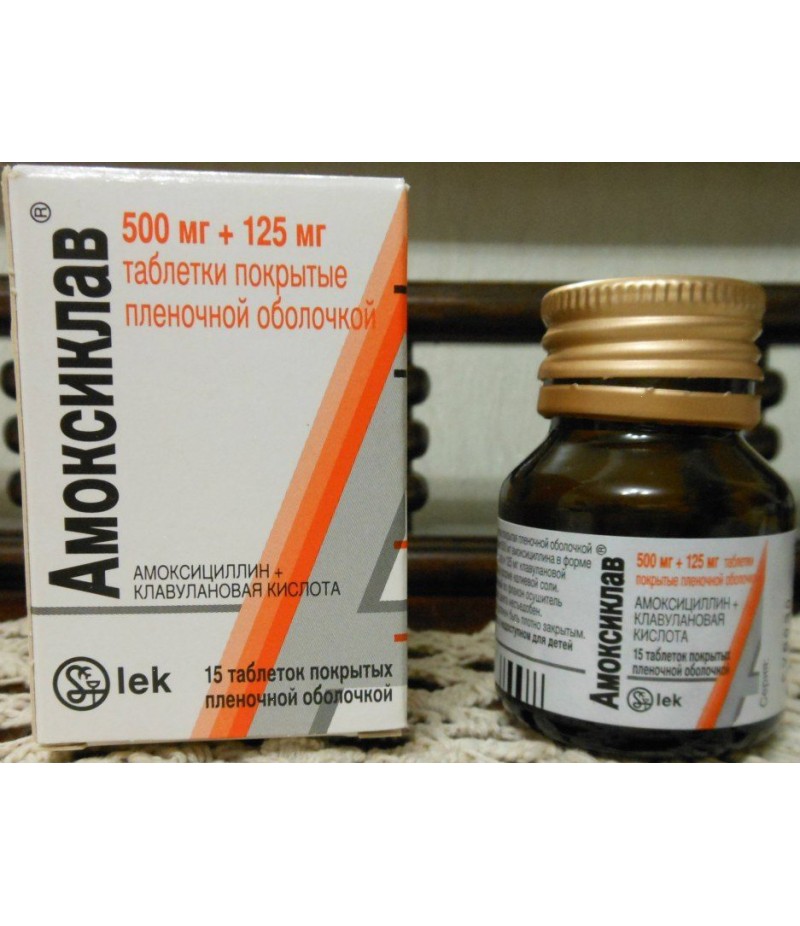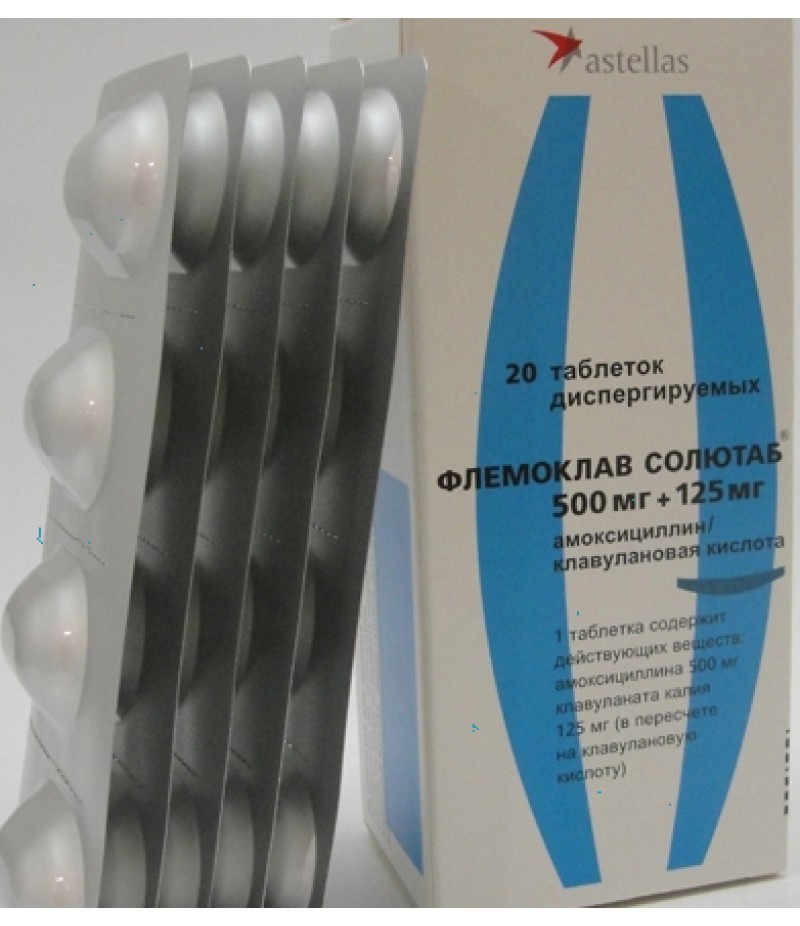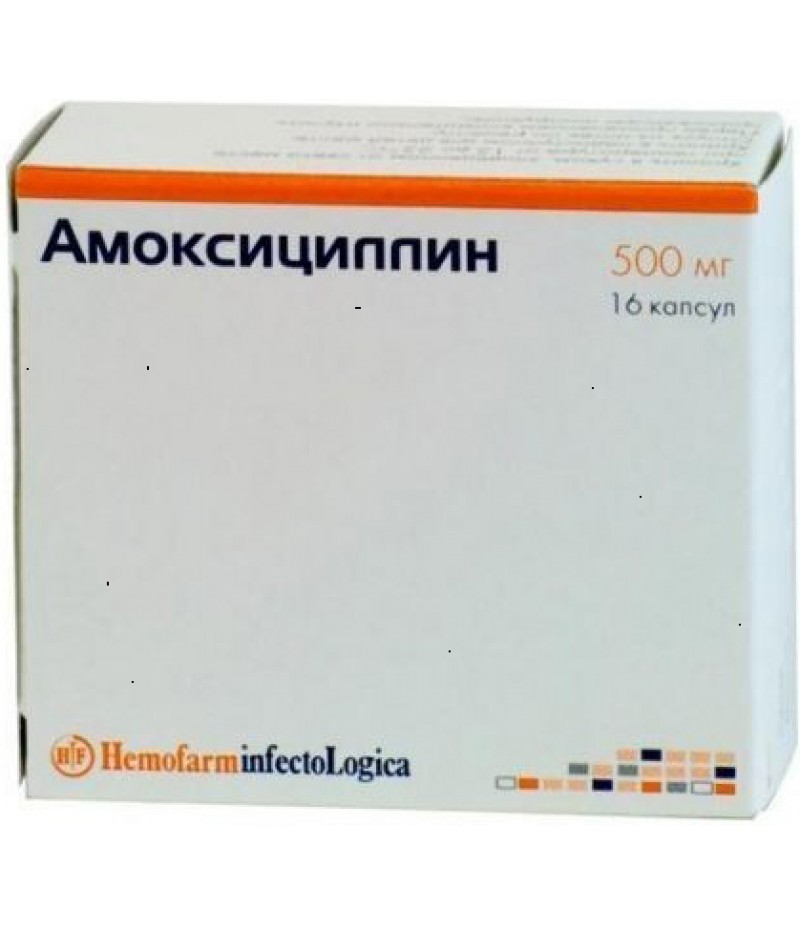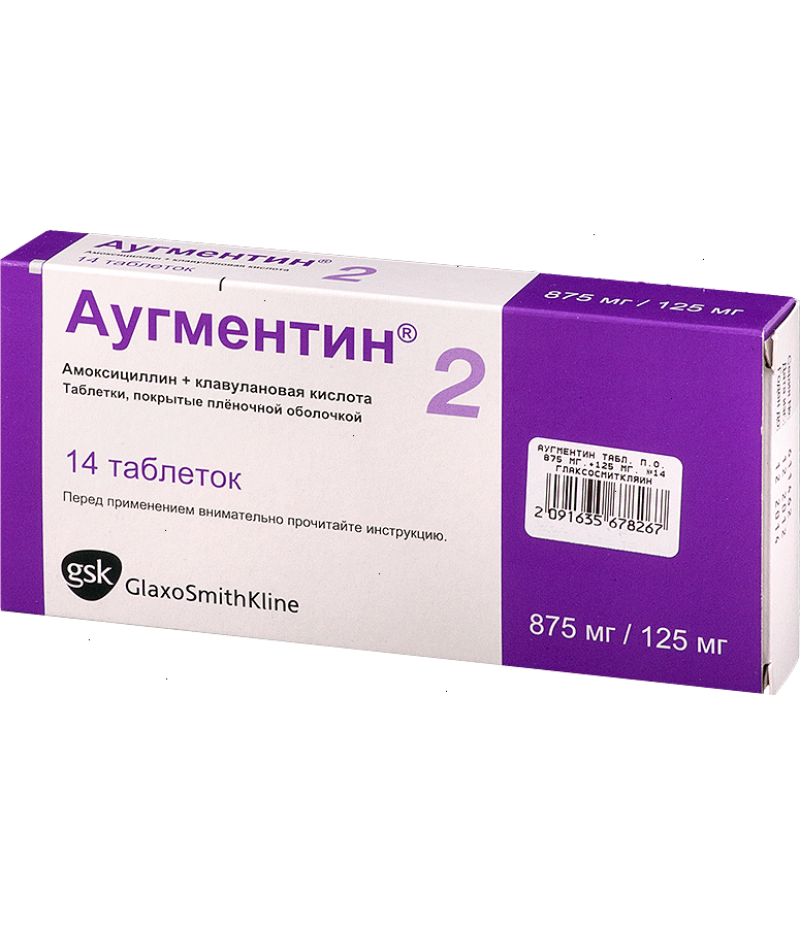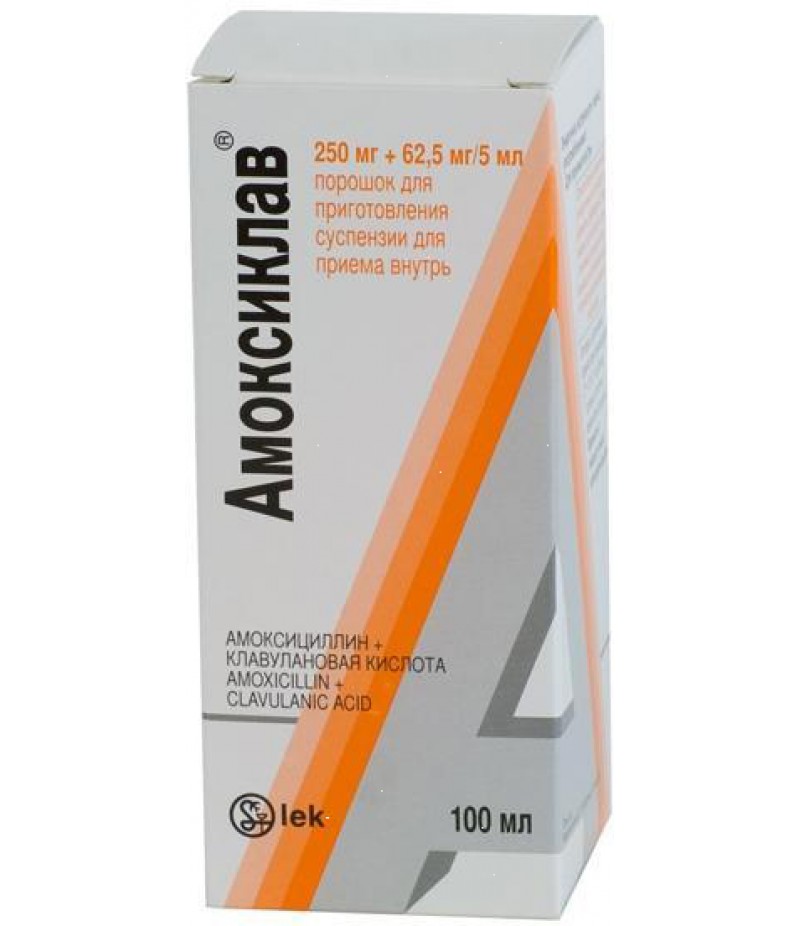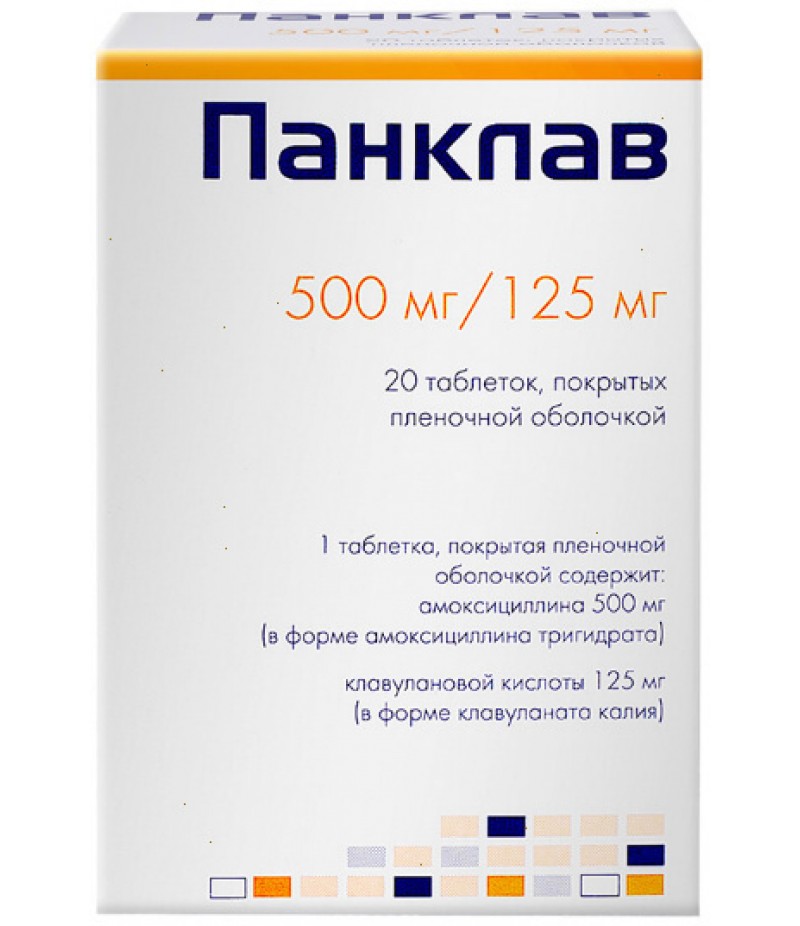Amoksiklav 500mg + 125mg #15
- $18.99
- 3 or more $17.50
- Availability:In Stock
You can buy Amoksiklav on this pageReed more and buy Amoksiklav hereComposition of AmoksiklavThe tablets of 250 mg / 125 mg contain the active ingredients amoxicillin (form of trihydrate) and clavulanic acid (form of potassium sal..
Tags: tabs
You can buy Amoksiklav on this page
Reed more and buy Amoksiklav here
Composition of Amoksiklav
The tablets of 250 mg / 125 mg contain the active ingredients amoxicillin (form of trihydrate) and clavulanic acid (form of potassium salt). Tablets also contain auxiliary components: MSC sodium croscarmellose.
Amoksiklav tablets 2X 625 mg and 1000 mg contain active components amoxicillin and clavulanic acid, as well as additional components: anhydrous colloidal silicon dioxide, flavoring agents, aspartame, yellow iron oxide, talc, hydrogenated castor oil, MCC silicate.
Amoksiklav Quiktab tablets 500 mg and 875 mg contain active ingredients amoxicillin and clavulanic acid, as well as additional components: anhydrous colloidal silica, flavors, aspartame, yellow iron oxide, talc, hydrogenated castor oil, MCC silicate.
Amoxicillin and clavulanic acid are also included in the powder from which the Amoksiklav suspension is prepared, and sodium citrate, MCC, sodium benzoate, mannitol, sodium saccharin are included as inactive components.
In the composition of the powder for the preparation of Amoksiklav infusion IV the amoxicillin and clavulanic acid are contained.
Form of issue
The drug is in the form of tablets. Amoksiklav 250 mg / 125 mg - coated tablets, the package contains 15 pcs.
Amoksiklav 2X (500 mg / 125 mg, 875 mg / 125 mg) - tablets that cover the skin, the package may contain 10 or 14 pcs.
Amoksiklav Quiktab (500 mg / 125 mg, 875 mg / 125 mg) is available in the form of dispersed tablets, in the package - 10 such tablets.
Also, the agent is made in the form of a powder from which the suspension is made, the vial contains a powder for preparing 100 ml of the agent.
A powder is also produced, from which a solution is made, which is administered intravenously. The vial contains 600 mg of the drug (amoxicillin 500 mg, clavulanic acid 100 mg), bottles of 1.2 g (amoxicillin 1000 mg, clavulanic acid 200 mg) are also available, the package contains 5 fl.
pharmachologic effect
The abstract provides information that the antibiotic Amoksiklav (INN Amoksiklav) is a means of a wide range of effects. Group of antibiotics: penicillins of a wide range of effects. The drug contains amoxicillin (penicillin semisynthetic) and clavulanic acid (inhibitor of β-lactamases). The presence of clavulanic acid in the formulation provides the resistance of amoxicillin to the action of β-lactamases, which are produced by microorganisms.
The structure of clavulanic acid is similar to beta-lactam antibiotics, this substance also has an antibacterial effect. Amoksiklav is active against strains that show sensitivity to amoxicillin. This is a series of gram-positive bacteria, aerobic gram-negative bacteria, gram-positive and gram-negative anaerobes.
Pharmacokinetics and pharmacodynamics
As the medication guide Vidal informs, after oral administration, both substances are actively absorbed from the digestive tract, the intake of components is not affected by food intake, so it does not matter how to take - before meals or after. The highest concentration in the blood is observed one hour after the drug was taken. Both active substances of the drug are distributed in liquids and tissues. Amoxicillin also enters the liver, synovial fluid, prostate, palatine tonsils, gall bladder, muscle tissue, saliva, the secret of bronchi.
If the membranes of the brain are not inflamed, through the BBB, both active substances do not penetrate. At the same time, the active components penetrate through the placental barrier, their traces are determined in breast milk. Blood proteins are bound to a small extent.
Amoxicillin is partially metabolized in the body, clavulanic acid is metabolized intensively. It is excreted from the body through the kidneys, small particles of active substances are excreted by the intestines and lungs. The half-life of amoxicillin and clavulanic acid is 1-1.5 h.
Indications for use of Amoksiklav
Amoksiklav is prescribed for diseases of an infectious and inflammatory nature that develop due to the influence of microorganisms sensitive to this drug. Such indications for the use of this drug are determined:
infection of the ENT organs, as well as infectious diseases of the upper respiratory tract (otitis media, zaglugal abscess, sinusitis, pharyngitis, tonsillitis);
infection of the urinary tract (with cystitis, with prostatitis, etc.);
infectious diseases of the lower respiratory tract (pneumonia, acute and chronic bronchitis);
gynecological diseases of an infectious nature;
infection of connective and bony tissues;
infectious diseases of soft tissues, skin (including the effects of bites);
infection of the biliary tract (cholangitis, cholecystitis);
odontogenic infections.
What helps Amoksiklav still, you should ask a specialist for individual consultation.
Contraindications
Determining why pills and other forms of the drug help, you should also take into account existing contraindications:
Infectious mononucleosis;
previously suffered liver disease or cholestatic jaundice when taking acid clavulanic or amoxicillin;
lymphocytic leukemia;
high sensitivity to antibiotic drugs from the group of cephalosporins, penicillins, and other beta-lactam antibiotics;
high sensitivity to the active ingredients of the drug.
Cautiously assigned to people suffering from liver failure, people with severe kidney disease.
Side effects
When taking this antibiotic, patients may experience the following side effects:
Digestive system: deterioration of appetite, vomiting, nausea, diarrhea; In rare cases, manifestations of pain in the abdomen, violations of the liver; single manifestations - hepatitis, jaundice, pseudomembranous colitis.
The system of hematopoiesis: in rare cases - reversible leukopenia, thrombocytopenia; in very rare cases - eosinophilia, pancytopenia.
Allergic manifestations: itching, erythematous rash, hives; in rare cases - anaphylactic shock, exudative erythema, edema, allergic vasculitis; single manifestations - Stevens-Johnson syndrome, pustulosis, exfoliative dermatitis.
Functions of the nervous system: dizziness, headache; in rare cases - convulsions, a sense of anxiety, hyperactivity, insomnia.
The urinary system: crystalluria, interstitial nephritis.
In rare cases, there may be a manifestation of superinfection.
It is noted that such treatment, as a rule, does not provoke significant side effects.
Instructions for the use of Amoksiklav (Method and dosage of Amoksiklav for adults)
Drugs in tablets are not prescribed for children under 12 years. Assigning the drug, it should be taken into account that the permissible dose per day of clavulanic acid is 600 mg (adult) and 10 mg per 1 kg of weight (child). The permissible dose per day of amoxicillin is 6 g for an adult and 45 mg for 1 kg of weight for a child.
The parenteral preparation is prepared by dissolving the contents of the vial in water for injection. To dissolve 600 mg of the drug, you need 10 moles of water to dissolve 1.2 g of the drug - 20 ml of water. The solution should be administered slowly, within 3-4 minutes. Intravenous infusion should continue for 30-40 minutes. It is impossible to freeze the solution.
Before anesthesia, to prevent purulent complications, intravenous injection of 1.2 g of drugs should be administered. If there is a risk of complications, the drug is administered intravenously or it is given orally after the operation. The duration of the appointment is determined by the doctor.
Amoksiklav tablets, instructions for use
As a rule, adults and children (who weigh more than 40 kg) receive every eight hours for 1 table. (375 mg), provided that the infection is mild or moderate. Another acceptable scheme of treatment in this case is reception every 12 hours 1 table. (500 mg + 125 mg). In severe infectious diseases, as well as in infectious diseases of the respiratory tract, reception is shown every eight hours 1 table. (500 mg + 125 mg) or administration every 12 hours 1 table. (875 mg + 125 mg). Depending on the disease, you need to take an antibiotic from five to fourteen days, but the doctor must individually designate a therapy regimen.
Patients with odontogenic infections show medication every 8 hours for 1 table. (250 mg + 125 mg) or once 12 hours for 1 table. (500 mg + 125 mg) for five days.
People suffering from moderate renal insufficiency are shown taking 1 table. (500 mg + 125 mg) every twelve hours. Renal failure of severe degree is the reason for increasing the interval between doses up to 24 hours.
Amoksiklav in case of angina
The drug Amoksiklav in case of angina to an adult is assigned to 1 table. 325 mg once every 8 hours. Another scheme of treatment involves taking 1 tablet once every 12 hours. A doctor may prescribe an antibiotic at a higher dose if the disease in an adult is severe. Treatment of angina in children involves the use of a suspension. Usually, 1 spoon is prescribed (dosage spoon is 5 ml). The frequency of admission is determined by a doctor whose recommendations are important to follow. How to take Amoksiklav for children with angina, depends on the severity of the disease.
Dosage of Amoksiklav in genyantema
Whether Amoksiklav helps with genyantritis, depends on the causes and peculiarities of the course of the disease. Dose is determined by the otolaryngologist. It is recommended to take pills of 500 mg three times a day. How many days to take medicine depends on the severity of the disease. But after the disappearance of the symptoms take the drug for two more days.
Overdose
To avoid an overdose, the prescribed dosage for children and dosage of Amoksiklav should be clearly observed for adults. It is recommended that you carefully study the instructions or watch a video of how to dilute the suspension.
Wikipedia indicates that overdose of the drug may manifest a number of unpleasant symptoms, but there are no data on life-threatening conditions of the patient. As a result of an overdose, there may be abdominal pain, vomiting, diarrhea, agitation. In severe cases, convulsions may occur.
If the drug was taken recently, gastric lavage is performed, activated charcoal is shown. The patient should be supervised by a doctor. In this case, hemodialysis is effective.
Interaction
With the simultaneous administration of the drug with some drugs, undesirable manifestations may occur, making the tablets, syrup and intravenous administration not to be used in parallel with a number of medications.
The simultaneous use of drugs with glucosamine, antacids, aminoglycosides, laxative drugs slows the absorption of Amoksiklav, when taken concomitantly with ascorbic acid - absorption is accelerated.
When simultaneous treatment with phenylbutazone, diuretics, NSAIDs, Allopurinol and other drugs that block tubular secretion, there is an increase in the concentration of amoxicillin.
If the simultaneous reception of anticoagulants and Amoksiklav, the prothrombin time increases. Therefore, it is necessary to assign funds in such a combination carefully.
Amoksiklav increases the toxicity of methotrexate when taken concomitantly.
When taking both Amoksiklav and Allopurinol, the likelihood of exanthema increases.
Do not simultaneously take disulfiram and Amoksiklav.
Antagonists at a joint admission are amoxicillin and Rifampicin. The drugs mutually weaken the antibacterial effect.
Do not take Amoksiklav and bacteriostatic antibiotics (tetracyclines, macrolides) and sulfonamides at the same time, as these drugs may reduce the effectiveness of Amoksiklav.
Probenecid increases the concentration of amoxicillin and slows its excretion.
When using Amoksiklav, the efficacy of oral contraceptives may be reduced.
Storage conditions
The medicine belongs to the list B. It is necessary to store it in a place inaccessible to children, at a temperature of no more than 25 ° C.
Shelf life 2 years.
special instructions
Since the majority of people with lymphatic leukemia and infectious mononucleosis who received Ampicillin subsequently noted the manifestation of erythematous rash, such people are not recommended to take antibiotics of the ampicillin group.
Caution is given to people with a tendency to allergies.
If for adults or children a course of treatment with the drug is prescribed, it is important to monitor the functions of the kidneys, the liver, the process of hematopoiesis.
People who have renal dysfunction, need a correction of the dose of the drug or an increase in the interval between taking drugs.
It is optimal to take the product in the process of eating to reduce the likelihood of side effects from the digestive system.
Patients undergoing treatment with Amoksiklave may experience a false positive reaction during the determination of glucose in the urine using a Felling solution or a Benedict reagent.
There is no evidence of the negative impact of Amoksiklav on the ability to drive vehicles and work with precise mechanisms.
Patients who are interested in Amoksiklav - an antibiotic or not, it should be noted that the drug is an antibacterial drug.
It is recommended to consume a lot of water and other liquids during the course of treatment with the drug.
If Amoksiklav is prescribed, the child's age should be taken into account when prescribing the drug form and dosage.
Analogues of Amoksiklav
Flemoclav Solutab and Amoksiklav: the difference between preparations
The active components of the preparations are similar. The difference between drugs is in the dosage of the active components in the forms of release of these drugs. Both drugs are related to approximately the same price category.
Amoksiklav for children
Children should take an antibiotic only after the appointment of a doctor. It is important to adhere to the indicated dosage. Children under 12 years are usually prescribed a suspension. The dosage of Amoksiklav suspension for children depends on the severity of the disease and the diagnosis. As a rule, children under 2 years of age are prescribed a dose of 62.5 mg, at the age from 2 to 7 years - 125 mg, at the age from 7 to 12 years - 250 mg.
Amoksiklav and alcohol
You can not combine this drug with alcohol. With simultaneous admission, the load on the liver increases significantly, and the likelihood of a number of negative effects increases.
Amoksiklav in pregnancy and lactation
Amoksiklav during pregnancy can be used in the event that the expected effect exceeds the possible harm to the fetus. It is undesirable to use Amoksiklav during early pregnancy. More preferable are the 2 trimester and 3 trimester, but during this period Amoksiklav dosage during pregnancy should be observed very accurately. Amoksiklav during breastfeeding is not prescribed, since the active components of the drug penetrate into breast milk.
Reviews about Amoksiklav
In the process of discussing the drug Amoksiklav, reviews of doctors and patients are mostly positive. It is noted that the antibiotic is effective in the treatment of respiratory diseases, and it is suitable for both adults and children. In the reviews mention the effectiveness of the remedy for sinusitis, with otitis, with infections of the genital tract. As a rule, adult patients take 875 mg + 125 mg tablets, provided that the dosage is correct, the relief comes quickly. In the reviews it is noted that after the course of treatment with an antibiotic it is desirable to take drugs that restore the normal microflora.
Reviews of the Amoksiklav suspension are also positive. Parents write that it is convenient to give the product to children, since it has a pleasant taste and is normally perceived by children.

